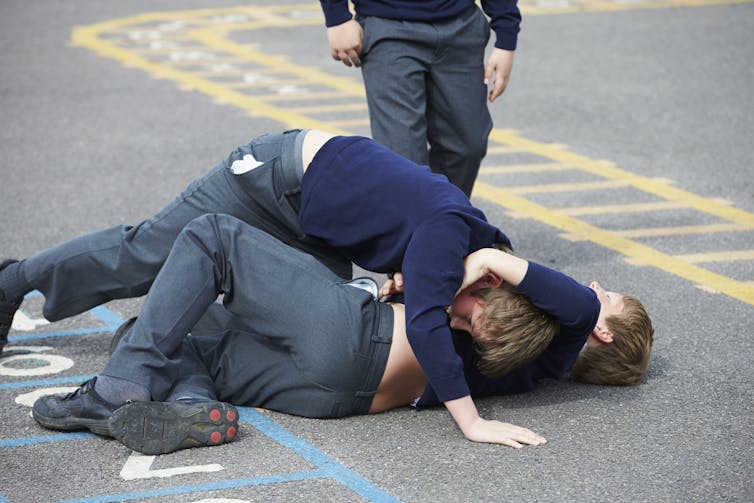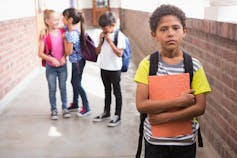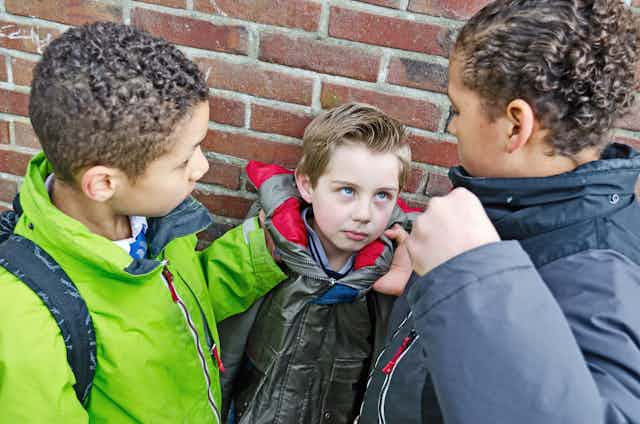If your child is being pushed around at school would you expect them to take the hit and seek support later, or fight back?
Ask any school administrator whether kids should hit back and you will get a decisive “No”. Most teachers agree that students should not hit back. And for good reason.
Hitting back may lead to an escalation in violence and can result in serious injury or fatalities.
Schools and teachers have a duty of care to keep all students safe; they cannot condone hitting back because of the risk of students being hurt.
So where does this leave victims, when school programs don’t stop the bullying?
Although most students agree that initiating violence is not acceptable, many recommend hitting back as a strategy to deter aggression and bullying.
It is not uncommon for parents also to recommend hitting back. Even teachers, when parenting their own children, sometimes advise their children to do this.
Apart from retaliation, hitting back includes elements of self-defence, which in Western society is generally accepted as legitimate. But proving the act was in self-defence can be challenging.
School policies and actions do not necessarily distinguish between initial aggression and hitting back in response to aggression. So students could well receive consequences (such as suspension) for hitting back, even if acting in self-defence.
Why encourage kids to hit back?
Research shows that boys are more likely to be both the victims and instigators of aggression.
Like students, parents who recommend hitting back often justify it as a deterrent to further aggression:
“I don’t want my son known for fighting, but I also don’t want him [to be] known as the kid who gets pushed around.”
Teachers who would recommend hitting back for their own child also report it might be in their own child’s best interests:
“As a father, I’m concerned only for my son’s safety. As a teacher, I have to look out for everyone. Personally [as a parent], I understand that if my children don’t hit back, they’ll become other children’s victims.”
Does fighting back deter further aggression?

There is some evidence to suggest that hitting back may prevent further bullying.
Several studies of pre-school and primary school-aged children have found that being submissive to peers and not retaliating increases children’s risk of ongoing bullying.
But the story is not that simple.
Of children who are bullied, those who hit back are more likely to be bullied six months later than children who don’t retaliate.
We now know that there are two distinct groups of children prone to ongoing bullying:
1. Passive
The first group are “passive victims”, who are submissive, timid, anxious and do not retaliate against peer aggression.
Children who bully can target these students without fear of retribution.
2. Provocative
The second group of children are known as “provocative victims” who lash out angrily with unskilled aggression.
Provocative victims are at even greater risk of ongoing bullying than passive victims because their actions keep the conflict going. They get caught in an ongoing cycle of revenge.
In many ways passive and provocative victims are at opposite extremes. However, they do have one crucial thing in common: their tendency to overreact.
This inability to control strong emotions is the single most important factor for determining ongoing victimisation.
Another factor also influences whether hitting back will encourage or discourage further aggression. And that is how competently and confidently the child fights back if they do go down this path.
Aggression in children has previously been distinguished as either “ineffectual” or “effectual”.
Children who are ineffectual aggressors become emotionally distressed, escalate conflicts into aggression, but end up losing fights. They are likely to keep being targeted for aggression and are, in other words, “provocative victims”.
Children who are effectual aggressors apply force quickly and effectively to get what they want. They are also rarely bullied. Included in effectual aggressors are children who bully and start fights; however, there are also children who do not bully, generally get on well with peers but respond decisively if ever assaulted.
Hitting back may deter further aggression if done calmly and competently, but if the child is highly emotional or physically unskilled, hitting back will make matters much worse.
What should kids do if they are being bullied?
There are several low-risk strategies likely to work when handling verbal or minor physical disputes:
- staying calm;
- standing up for yourself with words;
- sorting out misunderstandings;
- seeking help from a friend.
Our research shows that when a child is being bullied, most schools can improve the situation when made aware of the issue. So it’s important to inform schools of any concerns.
There are also many things that children and parents can do to prevent physical bullying.
Research shows that warm supportive parenting lowers children’s risk of being bullied by peers at school.

Having good friends also offers protection against bullying.
Parents can help by actively supporting their child’s friendships and coaching their child to respond calmly to negative behaviour from peers.
They can help children practise responding calmly and assertively to minor physical aggression from other students. For instance, if pinching is a concern, a parent can show their child how to calmly block pinching while telling the other child calmly and firmly to stop.
Most boys like to engage in friendly rough and tumble play. But this type of play tends to deteriorate into aggression with unpopular boys, but not with popular boys.
Aggressive boys are likely to misread actions of other boys as aggressive, and to escalate into violence.
Learning to engage in physical play within appropriate limits and to read physical situations is a useful skill for boys to learn.
Contact sports, such as rugby league, can offer boys practise having physical contact with other boys within clearly defined limits. This helps them build confidence in responding calmly to physical situations.
Schools have a duty of care to protect children from harm, but despite the vigilance of teachers, there are still occasions of students being seriously assaulted by other students.
Children need to learn how to recognise and keep away from potentially dangerous situations. They can also learn skills to defuse risky situations with calm body language and words.
But if a child is unable to avoid physical assault, it is in the child’s best interests that they have the skills and confidence to handle this situation calmly and competently.

